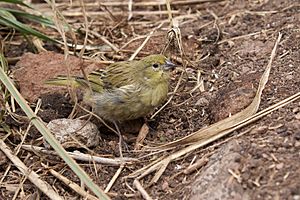Inaccessible Island finch facts for kids
Quick facts for kids Inaccessible Island finch |
|
|---|---|
 |
|
| On Inaccessible Island | |
| Conservation status | |
| Scientific classification | |
| Genus: |
Nesospiza
|
| Species: |
acunhae
|
 |
|
The Inaccessible Island finch (Nesospiza acunhae) is a special type of bird that lives only on Inaccessible Island. This island is part of the Tristan da Cunha group, far out in the Atlantic Ocean. People sometimes call it the Inaccessible bunting. It belongs to a bird family called Thraupidae.
This unique bird can only be found on Inaccessible Island. It lives in places like cool shrubland and grassy areas. Sadly, its home is shrinking, which means it is a threatened species.
Contents
About the Inaccessible Island Finch
The Inaccessible Island finch is a small to medium-sized bird. It measures about 17 to 21 centimeters (6.7 to 8.3 inches) long. It weighs between 24 and 49 grams (0.8 to 1.7 ounces). All these birds have shades of olive-green feathers. When they call out, they make a repeated sound of three or four notes.
Different Types of Finches
Scientists used to think there were two different kinds of Inaccessible Island finches. But now, they group them all together as one species with three different types, called subspecies.
N. a. acunhae
This type of finch lives along the island's coastline. It has a small beak. Its feathers are a dull olive-grey color. The male birds are a bit brighter than the females.
N. a. dunnei
You can find this finch on the eastern side of the island's high plateau and also near the coast. It has a larger beak compared to the other types. This subspecies is also bigger in size than the others.
N. a. fraseri
This finch lives higher up on the island's plateau, between 300 and 600 meters (984 and 1969 feet) high. It has a small beak. Its feathers are a bright yellow color. This type of finch also has a large head and long wings.
What the Finches Eat
The Inaccessible Island finch mostly eats seeds and insects. The types of plants they eat can be different for each subspecies.
- N. a. acunhae eats seeds from Spartinia grasses, like Sporobolus arundinacea, and also Carex plants.
- N. a. fraseri enjoys eating Nertera plants.
- N. a. dunnei feeds on Phylica plants.
All types of Inaccessible Island finches also rely on flies as an important part of their diet.
Life Cycle and Reproduction
Inaccessible Island finches lay their eggs between November and February. They usually stay with one partner for many breeding seasons. The female bird lays one or two eggs. She builds a cup-shaped nest close to the ground.


